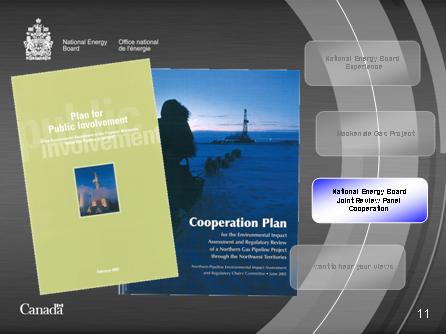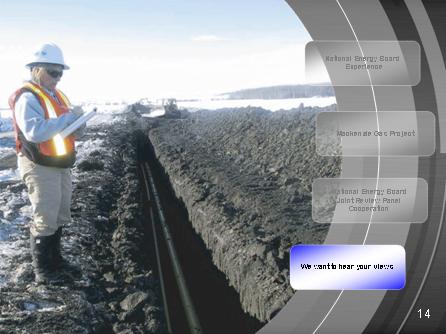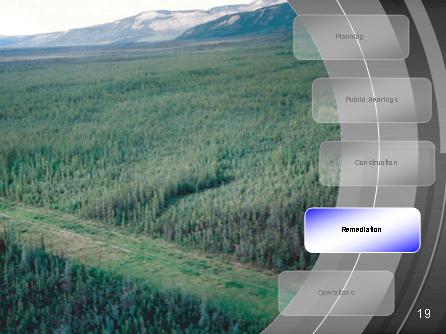
Environment

Mackenzie Gas Project
Pre-hearing Planning Conference
Presented by
Kenneth Vollman, Chairman
Gaétan Caron, Vice-Chairman
David Hamilton, Board Member
National Energy Board
Inuvik, Yellowknife, Fort Good Hope and Fort Simpson
December 2005

- Purpose of Conference
- Who is the National Energy Board?
- Board Members
- Oil / Gas Pipelines
- Mackenzie Gas Project Board Panel
- In the Public Interest
- Why is the National Energy Board here?
- National Energy Board Experience
- Mackenzie Gas Project
- National Energy Board and Joint Review Panel Cooperation
- National Energy Board and Joint Review Panel Cooperation (continued)
- We want to hear your views
- We want to hear your views (continued)
- The lifecycle of a pipeline
- Planning
- Public Hearings
- Construction
- Remediation
- Operations
- Sharing Knowledge - Your Views?
Purpose of Conference

The Panel would like to take a few minutes to give you some information about who the National Energy Board is, why we are here today, and what our role typically is throughout the lifecycle of a pipeline.
Who is the National Energy Board?

Since 1959 the National Energy Board has been regulating pipelines and other energy facilities across Canada. For pipelines we have two main responsibilities:
- to make independent decisions on whether or not pipelines should be built; and
- to monitor the construction and operation of pipelines that are built.
Board Members

The National Energy Board has 8 full time members, 2 temporary members and about 300 staff, all located in Calgary. Our decisions are based on the knowledge that people share with us during our hearings.
Oil / Gas Pipelines

The National Energy Board is responsible for 45 000 km of pipelines across Canada. Some of these are gas pipelines; others transport oil. We have developed relationships with people across Canada because the pipelines we regulate are found all across Canada.
Mackenzie Gas Project Board Panel

The National Energy Board is independent. As the 3 appointed Board members, we will make the decision on the Mackenzie Gas Project.
In the Public Interest

For us to make a good decision, we hear from many different people:
- those who live on the land where the pipeline would go;
- those who would use the gas that the pipeline transports;
- those who want to build the pipeline;
- those who are opposed to the pipeline being built; and
- those who have an interest in the project and the land it would affect.
The National Energy Board makes its decision about a pipeline "in the public interest". This means that we need to consider the interests that people express about the proposed pipeline.
Why is the National Energy Board here?

It is the proposed Mackenzie Gas Project that brings us back to the North today to talk with you about our hearing process for this project.
National Energy Board Experience

The NEB has regulated energy-related activities in the North since the early '60s. This includes exploration and production activities on and offshore in the '70s, the construction of oil and gas pipelines in the 80's and, more recently, renewed exploration and development activities in and around the Mackenzie Valley.
Mackenzie Gas Project

The National Energy Board's role for the Mackenzie Gas Project is to decide whether or not the pipeline should be built.
I'd like to take one minute and go over the main elements of the project in the 5 applications that the National Energy Board has received:
- We have received Development Plan applications for Niglintgak, Parsons Lake, and Taglu, which are all located north of Inuvik;
- We have an application for the gathering system, which includes a processing plant near Inuvik and a buried pipeline from Inuvik to Norman Wells that will carry natural gas liquids;
- And finally, we have an application for a buried natural gas pipeline that would run from Inuvik down into Alberta, which is the Mackenzie Valley Pipeline.
National Energy Board and Joint Review Panel Cooperation

Because of the size of this project and the various jurisdictions that the pipeline would pass through, a Cooperation Plan was created to provide for both the environmental assessment and a regulatory review of the project. It is important that these review processes be coordinated.
The different members of the Joint Review Panel and the National Energy Board were chosen because of the knowledge and expertise that each one brings to the review of the project. However, both Panels are looking for knowledge from many other people.
During its hearings, the Joint Review Panel will be listening to people's views on the environment, social and cultural effects that could happen if the pipeline was built.
During the National Energy Board hearing, we will be listening to people's views on the engineering, safety, and economic effects that could happen if the pipeline was built.
The Joint Review Panel will write its report and give its recommendations to the Government of Canada and to the National Energy Board.
National Energy Board and Joint Review Panel Cooperation Involvement (continued)

Before we make a decision on whether or not the pipeline should be built, we will read and consider that report to find out about these important matters. With a good flow of knowledge between interested people and the Panels, the best decision can be made.
We want to hear your views

The exchange of knowledge is a critical part of the National Energy Board hearing process.
It is in the hearing process that people meet and exchange their knowledge. For example, information on the route of the pipeline, engineering design and construction techniques, and ways to minimize negative impacts or to increase positive impacts are all dealt with at the hearing.
It is after the exchange of information throughout the hearing that the National Energy Board makes a decision on whether or not to approve the pipeline.
We want to hear your views (continued)

If the decision is to approve the project, then the National Energy Board will regulate the pipeline throughout its life. Any decision to approve comes with a number of conditions which are based on the knowledge that was shared during the hearing. Our inspectors would then verify that the pipeline is in compliance with these conditions.
The lifecycle of a pipeline
We can divide a pipeline lifecycle into 5 phases - planning, public hearings, construction, remediation and operations. I'll talk a bit about each phase.
Planning

For the Mackenzie Gas Project, the National Energy Board worked with government departments, Boards and agencies to develop the Cooperation Plan that David spoke about. Other important information that is shared during the planning phase includes:
- information about the project from the company;
- knowledge about the land from the people; and
- information about the review process from the Panels.
It is during this phase that the hearing process is designed to meet the needs of people who are interested in the project. Today's session is one step in the planning process.
Public Hearings

The hearing process is designed so that people can exchange their knowledge about the pipeline and the effects it could have on the people and the land.
What does a successful hearing look like? It is one where people have respect for diverse views while exchanging information about the proposed project. As the National Energy Board, our job is then to make a decision on the pipeline that takes into account the different views that people have shared.
Construction

If the decision is made to approve the pipeline, then the next phase is construction. But if the decision is to not approve the pipeline, then there will be no construction - that is the end of the project.
If a pipeline is approved, the National Energy Board puts conditions on its construction and operation and, we ensure that these conditions are met throughout the life of the pipeline. We have inspectors to help us do that.
Remediation

Like the proposed Mackenzie Valley Pipeline, most pipelines are buried during construction about 2 to 3 feet down. After construction, the our inspectors monitor the company's mitigation activities for success in restoring the land. For example, commitments may have been made to restore native vegetation.
Operations

During operations, the National Energy Board continues to be responsible for regulating the pipeline. We inspect the pipeline to verify that that the pipeline is operated safely, that environmental protection activities continue, and that commitments the company has made are being met. If concerns arise, people know who the National Energy Board is and how to reach us. We will respond to, and deal fairly with, these concerns.
Sharing Knowledge - Your Views?

| Updated: 2006-10-25 | Important Notices | |
